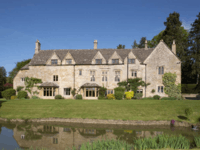Icomb Place

Icomb Place (pronounced "Ickum") is a medieval manor house on the edge of the village of Icomb, near Stow on the Wold in Gloucestershire. The word "Place" in this context is thought to be a precursor of the word "Palace".
Description
The house is a Grade I listed building.[1] Mentioned in the Domesday Book, the present house dates from three distinct periods. The house seems to have started out as a modest courtyard dwelling, but soon afterwards was made grander by the creation of the great hall, the remodelling of the solar range and the building of the entrance range. The great hall is disproportionally large and its upper end obtrudes into the line of the solar range.[2]
The oldest parts of the present building date from c. 1230 and include the chapel and solar (with barrel vaulted timber roof) and undercroft (northwest wing) and the southeast wing, originally the kitchens and servants' quarters. The great hall is a substantial room of 44 by 20 ft (13 by 6 m) and is divided into five bays by braced collar-beam trusses in the walls at the side. Other similar trusses are hidden above the bedroom ceilings. These bedrooms have original fireplaces connected to mid-level chimney stacks.[2]
The front of the house, including the battlemented gateway and the great hall, connecting the original 13th-century buildings, is thought to have been added in c.1420 by Sir John Blacket (who fought alongside Henry V of England at the Battle of Agincourt and is buried in the nearby church). At this point the house had two courtyards.[2] Most of the oak timber used in the building was felled in the winter of 1421/1422 from the nearby Cirencester area.
After a period of dereliction during the 18th and 19th centuries the house was restored at the beginning of the 20th century and the rear wing and courtyard were demolished. At the same time as the restoration, an arboretum was laid out in the grounds containing plants from around the globe.[3]
References
- ↑ Historic England. "Icomb Place (Grade I) (1153494)". National Heritage List for England. Retrieved 19 November 2015.
- 1 2 3 Anthony Emery (2006). Greater Medieval Houses of England and Wales, 1300–1500: Volume 3, Southern England. Cambridge University Press. pp. 108–110. ISBN 978-1-139-44919-9.
- ↑ Tony Russell (2013). The Cotswolds' Finest Gardens. Amberley Publishing. ISBN 978-1-4456-1472-4.
- Christopher Simon Sykes, Ancient English Houses 1240–1612 (London: Chatto & Windus) 1988
Coordinates: 51°54′0.35″N 1°41′41.5″W / 51.9000972°N 1.694861°W